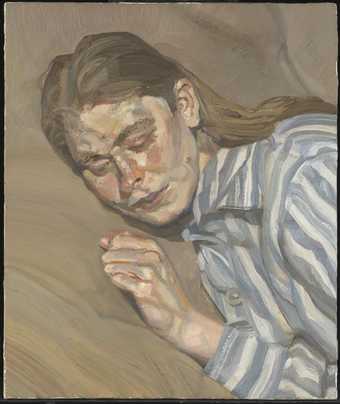
Lucian Freud
Girl in a Striped Nightshirt
(1983–5)
Tate
It may be strange that a conceptualist artist picks a Lucian Freud painting rather than the work of a respected colleague. However, against all potential prejudices, mystery and miracles still stand for an expansion of knowledge in no matter what kind of art is made, even in conceptualism. It is from this point of view that in Freud’s paintings - those past his relation to the Neue Sachlichkeit - I see the achievement of magical transmutation.
Trivial rendering, no matter how well it is done, basically means transferring data from outside reality on to the canvas and trying to maintain the same order of information. Freud, however, in line with Velázquez and Manet, manages a very different process. Paint is moved around on the canvas to become not just skin, but to carry with it living flesh and thought. The subjects are reborn from the surface of the canvas outward. They become true interlocutors with the viewer. They are not represented as in traditional painting just as a document or a memory, but are presented as irreplaceable beings.
Walking towards the painting and past the expected distance that holds the image together, one is allowed to see the building blocks, the brush strokes. But unlike the dots that make up a half-tone image to fake a continuous grey photograph in a newspaper, in Freud’s work these units are not dead and meaningless. The brush strokes show themselves to be the genetic structure that gives life to the total, while keeping life going in even the smallest unit. Wow.
Luis Camnitzer (born 1937) lives in Great Neck, New York
